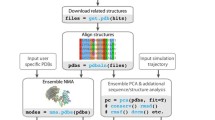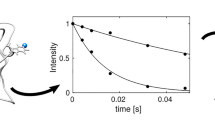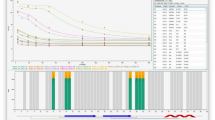Abstract
To facilitate rigorous analysis of molecular motions in proteins, DNA, and RNA, we present a new version of ROTDIF, a program for determining the overall rotational diffusion tensor from single- or multiple-field nuclear magnetic resonance relaxation data. We introduce four major features that expand the program’s versatility and usability. The first feature is the ability to analyze, separately or together, 13C and/or 15N relaxation data collected at a single or multiple fields. A significant improvement in the accuracy compared to direct analysis of R 2/R 1 ratios, especially critical for analysis of 13C relaxation data, is achieved by subtracting high-frequency contributions to relaxation rates. The second new feature is an improved method for computing the rotational diffusion tensor in the presence of biased errors, such as large conformational exchange contributions, that significantly enhances the accuracy of the computation. The third new feature is the integration of the domain alignment and docking module for relaxation-based structure determination of multi-domain systems. Finally, to improve accessibility to all the program features, we introduced a graphical user interface that simplifies and speeds up the analysis of the data. Written in Java, the new ROTDIF can run on virtually any computer platform. In addition, the new ROTDIF achieves an order of magnitude speedup over the previous version by implementing a more efficient deterministic minimization algorithm. We not only demonstrate the improvement in accuracy and speed of the new algorithm for synthetic and experimental 13C and 15N relaxation data for several proteins and nucleic acids, but also show that careful analysis required especially for characterizing RNA dynamics allowed us to uncover subtle conformational changes in RNA as a function of temperature that were opaque to previous analysis.












Similar content being viewed by others
References
Akke M, Fiala R, Jiang F, Patel D, Palmer A (1997) Base dynamics in a UUCG tetraloop RNA hairpin characterized by 15N spin relaxation: correlations with structure and stability. RNA 3(7):702–709
Berlin K, O’Leary DP, Fushman D (2009) Improvement and analysis of computational methods for prediction of residual dipolar couplings. J Magn Reson 201(1):25–33
Berlin K, O’Leary DP, Fushman D (2010) Structural assembly of molecular complexes based on residual dipolar couplings. J Am Chem Soc 132(26):8961–8972
Berlin K, O’Leary DP, Fushman D (2011) Fast approximations of the rotational diffusion tensor and their application to structural assembly of molecular complexes. Proteins Struct Funct Bioinform 79(7):2268–2281
Blackledge M, Cordier F, Dosset P, Marion D (1998) Precision and uncertainty in the characterization of anisotropic rotational diffusion by 15N relaxation. J Am Chem Soc 120(18):4538–4539
Boisbouvier J, Wu Z, Ono A, Kainosho M, Bax A (2003) Rotational diffusion tensor of nucleic acids from 13C NMR relaxation. J Biomol NMR 27:133–142
Bruschweiler R, Liao X, Wright P (1995) Long-range motional restrictions in a multidomain zinc-finger protein from anisotropic tumbling. Science 268(5212):886–889
Bryce DL, Grishaev A, Bax A (2005) Measurement of ribose carbon chemical shift tensors for A-form RNA by liquid crystal NMR spectroscopy. J Am Chem Soc 127(20):7387–7396
Case DA (1999) Calculations of NMR dipolar coupling strengths in model peptides. J Biomol NMR 15(2):95–102
Clore GM, Szabo A, Bax A, Kay LE, Driscoll PC, Gronenborn AM (1990) Deviations from the simple two-parameter model-free approach to the interpretation of nitrogen-15 nuclear magnetic relaxation of proteins. J Am Chem Soc 112(12):4989–4991
d’Auvergne EJ, Gooley PR (2003) The use of model selection in the model-free analysis of protein dynamics. J Biomol NMR 25:25–39
d’Auvergne EJ, Gooley PR (2008) Optimisation of nmr dynamic models ii. A new methodology for the dual optimisation of the model-free parameters and the brownian rotational diffusion tensor. J Biomol NMR 40(2):121–133
Dayie KT, Wagner G, Lefevre JF (1996) Theory and practice of nuclear spin relaxation in proteins. Annu Rev Phys Chem 47(1):243–282
Dayie KT, Brodsky AS, Williamson JR (2002) Base flexibility in HIV-2 TAR RNA mapped by solution 15N, 13C NMR relaxation. J Mol Biol 317(2):263–278
Dayie TK (2013) Nucleic acids: dynamics studies by solution NMR. Wiley, New York
DeLano W (2002) The PyMOL user’s manual. DeLano Scientific, San Carlos, CA, 382
Dethoff E, Chugh J, Mustroe A, Al-Hashimi H (2012) Functional complexity and regulation through RNA dynamics. Nature 482:322–330
Dosset P, Hus JC, Blackledge M, Marion D (2000) Efficient analysis of macromolecular rotational diffusion from heteronuclear relaxation data. J Biomol NMR 16(1):23–28
Duchardt E, Schwalbe H (2005) Residue specific ribose and nucleobase dynamics of the cUUCGg RNA tetraloop motif by NMR 13C relaxation. J Biomol NMR 32(4):295–308
Eldho N, Dayie K (2007) Internal bulge and tetraloop of the catalytic domain 5 of a group II intron ribozyme are flexible: implications for catalysis. J Mol Biol 365(4):930–944
Farrow N, Zhang O, Szabo A, Torchia D, Kay L (1995) Spectral density function mapping using 15N relaxation data exclusively. J Biomol NMR 6(2):153–162
Ferner J, Villa A, Duchardt E, Widjajakusuma E, Wohnert J, Stock G, Schwalbe H (2008) Nmr and md studies of the temperature-dependent dynamics of rna ynmg-tetraloops. Nucleic Acid Res 36:1928–1940
Fushman D (2012) Determining protein dynamics from 15N relaxation data by using DYNAMICS. In: Shekhtman A, Burz DS (eds) Protein NMR techniques, methods in molecular biology, vol 831, Humana Press, Clifton, pp 485–511
Fushman D, Cowburn D (1998a) Model-independent analysis of 15N chemical shift anisotropy from NMR relaxation data. ubiquitin as a test example. J Am Chem Soc 120(28):7109–7110
Fushman D, Cowburn D (1998b) Studying protein dynamics with NMR relaxation. J Biomol Struct Dyn 16(1):63–74
Fushman D, Cowburn D (1999) The effect of noncollinearity of 15N–1H dipolar and 15N CSA tensors and rotational anisotropy on 15N relaxation, CSA/dipolar cross correlation, and TROSY. J Biomol NMR 13(2):139–147
Fushman D, Cowburn D (2001) Nuclear magnetic resonance relaxation in determination of residue-specific 15N chemical shift tensors in proteins in solution: protein dynamics, structure, and applications of transverse relaxation optimized spectroscopy. Methods Enzymol 339:109–122
Fushman D, Cowburn D (2002) In: Rama Krishna N, Berliner LJ (eds) Protein NMR for the millenium (Biological Magnetic Resonance Vol. 20). Kluwer, Dordrecht
Fushman D, Weisemann R, Thüring H, Rüterjans H (1994) Backbone dynamics of ribonuclease T1 and its complex with 2’ GMP studied by two-dimensional heteronuclear NMR spectroscopy. J Biomol NMR 4(1):61–78
Fushman D, Cahill S, Cowburn D (1997) The main-chain dynamics of the dynamin pleckstrin homology (PH) domain in solution: analysis of 15N relaxation with monomer/dimer equilibration. J Mol Biol 266(1):173–194
Fushman D, Tjandra N, Cowburn D (1999a) An approach to direct determination of protein dynamics from 15N nmr relaxation at multiple fields, independent of variable 15N chemical shift anisotropy and chemical exchange contributions. J Am Chem Soc 121(37):8577–8582
Fushman D, Xu R, Cowburn D (1999b) Direct determination of changes of interdomain orientation on ligation: use of the orientational dependence of 15N NMR relaxation in Abl SH (32). Biochemistry 38(32):10225–10230
Fushman D, Ghose R, Cowburn D (2000) The effect of finite sampling on the determination of orientational properties: a theoretical treatment with application to interatomic vectors in proteins. J Am Chem Soc 122(43):10640–10649
Fushman D, Varadan R, Assfalg M, Walker O (2004) Determining domain orientation in macromolecules by using spin-relaxation and residual dipolar coupling measurements. Prog Nucl Magn Reson Spectrosc 44(3–4):189–214
Ghose R, Fushman D, Cowburn D (2001) Determination of the rotational diffusion tensor of macromolecules in solution from NMR relaxation data with a combination of exact and approximate methods—application to the determination of interdomain orientation in multidomain proteins. J Magn Reson 149(2):204–217
Hall JB, Fushman D (2003) Characterization of the overall and local dynamics of a protein with intermediate rotational anisotropy: differentiating between conformational exchange and anisotropic diffusion in the B3 domain of protein G. J Biomol NMR 27:261–275
Hall JB, Fushman D (2006) Variability of the 15N chemical shielding tensors in the B3 domain of protein G from 15N relaxation measurements at several fields. Implications for backbone order parameters. J Am Chem Soc 128(24):7855–7870
Hansen AL, Al-Hashimi HM (2006) Insight into the CSA tensors of nucleobase carbons in RNA polynucleotides from solution measurements of residual CSA: towards new long-range orientational constraints. J Magn Reson 179(2):299–307
Hoogstraten CG, Wank JR, Pardi A (2000) Active site dynamics in the lead-dependent ribozyme. Biochemistry 39(32):9951–9958
Ishima R, Nagayama K (1995) Protein backbone dynamics revealed by quasi spectral density function analysis of amide N-15 nuclei. Biochemistry 34(10):3162–3171
Kroenke CD, Loria JP, Lee LK, Rance M, Palmer AG (1998) Longitudinal and transverse 1H–15N dipolar/15N chemical shift anisotropy relaxation interference: unambiguous determination of rotational diffusion tensors and chemical exchange effects in biological macromolecules. J Am Chem Soc 120(31):7905–7915
Lee L, Rance M, Chazin W, Palmer A (1997) Rotational diffusion anisotropy of proteins from simultaneous analysis of 15N and 13Cα nuclear spin relaxation. J Biomol NMR 9(3):287–298
Legault P, Hoogstraten CG, Metlitzky E, Pardi A (1998) Order, dynamics and metal-binding in the lead-dependent ribozyme. J Mol Biol 284(2):325–335
Leulliot N, Varani G (2001) Current topics in RNA-protein recognition, control of specificity and biological function through induced fit and conformational capture. Biochemistry 40:7947–7956
Lipari G, Szabo A (1982) Model-free approach to the interpretation of nuclear magnetic resonance relaxation in macromolecules. 1. Theory and range of validity. J Am Chem Soc 104(17):4546–4559
Mandel AM, Akke M, Palmer~III AG (1995) Backbone dynamics of escherichia coli ribonuclease HI: correlations with structure and function in an active enzyme. J Mol Biol 246(1):144–163
Mittermaier A, Kay LE (2006) New tools provide new insights in NMR studies of protein dynamics. Science 312(5771):224–228
Nozinovic S, Fürtig B, Jonker H, Richter C, Schwalbe H (2010) High-resolution NMR structure of an RNA model system: the 14-mer cUUCGg tetraloop hairpin RNA. Nucleic Acids Res 38(2):683–694
Peng JW (2012) Exposing the moving parts of proteins with nmr spectroscopy. J Phys Chem Lett 3(8):1039–1051
Peng JW, Wagner G (1995) Frequency spectrum of NH bonds in eglin C from spectral density mapping at multiple fields. Biochemistry 34(51):16733–16752
Powell MJD (2009) The BOBYQA algorithm for bound constrained optimization without derivatives. technical report na2009/06. Tech. Rep. NA2009/06, Department of Applied Mathematics and Theoretical Physics, Cambridge University, Cambridge, England
Pozzi N, Vogt AD, Gohara DW, Di Cera E (2012) Conformational selection in trypsin-like proteases. Curr Opin Struct Biol 22(4):421–431
Rinnenthal J, Buck J, Ferner J, Wacker A, Furthig B, Schwalbe H (2011) Mapping the landscape of RNA dynamics with NMR spectroscopy. Acc Chem Res 44:1292–1301
Ryabov Y, Fushman D (2006) Interdomain mobility in di-ubiquitin revealed by nmr. Proteins Struct Funct Bioinform 63(4):787–796
Ryabov Y, Fushman D (2007a) A model of interdomain mobility in a multidomain protein. J Am Chem Soc 129(11):3315–3327
Ryabov Y, Fushman D (2007b) Structural assembly of multidomain proteins and protein complexes guided by the overall rotational diffusion tensor. J Am Chem Soc 129(25):7894–7902
Ryabov Y, Geraghty C, Varshney A, Fushman D (2006) An efficient computational method for predicting rotational diffusion tensors of globular proteins using an ellipsoid representation. J Am Chem Soc 128(48):15432–15444
Ryabov Y, Clore G, Schwieters C (2010) Direct use of 15N relaxation rates as experimental restraints on molecular shape and orientation for docking of protein–protein complexes. J Am Chem Soc 132(17):5987–5989
Seetharaman M, Eldho N, Padgett R, Dayie K (2006) Structure of a self-splicing group II intron catalytic effector domain 5: parallels with spliceosomal u6 RNA. RNA 12(2):235
Shajani Z, Varani G (2007) NMR studies of dynamics in rna and dna by 13C relaxation. Biopolymers 86:348–359
Sheppard D, Li DW, Brüschweiler R, Tugarinov V (2009) Deuterium spin probes of backbone order in proteins: 2H NMR relaxation study of deuterated carbon α sites. J Am Chem Soc 131(43):15853–15865
Sheppard D, Li DW, Godoy-Ruiz R, Brüschweiler R, Tugarinov V (2010) Variation in quadrupole couplings of α deuterons in ubiquitin suggests the presence of Cα–Hα⋯O=C hydrogen bonds. J Am Chem Soc 132(22):7709–7719
Stueber D, Grant DM (2002) 13C and 15N chemical shift tensors in adenosine, guanosine dihydrate, 2′-deoxythymidine, and cytidine. J Am Chem Soc 124(35):10539–10551
Tjandra N, Bax A (1997) Large variations in 13Cα chemical shift anisotropy in proteins correlate with secondary structure. J Am Chem Soc 119(40):9576–9577
Tjandra N, Feller S, Pastor R, Bax A (1995) Rotational diffusion anisotropy of human ubiquitin from 15N NMR relaxation. J Am Chem Soc 117(50):12562–12566
Tjandra N, Garrett D, Gronenborn A, Bax A, Clore G (1997) Defining long range order in NMR structure determination from the dependence of heteronuclear relaxation times on rotational diffusion anisotropy. Nat Struct Mol Biol 4(6):443–449
Walker O, Varadan R, Fushman D (2004) Efficient and accurate determination of the overall rotational diffusion tensor of a molecule from 15N relaxation data using computer program ROTDIF. J Magn Reson 168:336–345
Woessner D (1962) Nuclear spin relaxation in ellipsoids undergoing rotational Brownian motion. J Chem Phys 37:647
Wu Z, Delaglio F, Tjandra N, Zhurkin V, Bax A (2003) Overall structure and sugar dynamics of a DNA dodecamer from homo-and heteronuclear dipolar couplings and 31 P chemical shift anisotropy. J Biomol NMR 26(4):297–315
Ying J, Grishaev A, Bryce DL, Bax A (2006) Chemical shift tensors of protonated base carbons in helical RNA and DNA from NMR relaxation and liquid crystal measurements. J Am Chem Soc 128(35):11443–11454
Acknowledgments
This work was supported by the NIH Grants GM095755 and GM065334 to DF and GM077326 to TKD, and Maryland Biotechnology award to TKD. We thank Vitali Tugarinov for providing relaxation data for ubiquitin. ROTDIF, including the source code, can be downloaded from http://bitbucket.org/kberlin/armor or http://gandalf.umd.edu/FushmanLab/pdsw.
Author information
Authors and Affiliations
Corresponding author
Electronic supplementary material
Below is the link to the electronic supplementary material.
Rights and permissions
About this article
Cite this article
Berlin, K., Longhini, A., Dayie, T.K. et al. Deriving quantitative dynamics information for proteins and RNAs using ROTDIF with a graphical user interface. J Biomol NMR 57, 333–352 (2013). https://doi.org/10.1007/s10858-013-9791-1
Received:
Accepted:
Published:
Issue Date:
DOI: https://doi.org/10.1007/s10858-013-9791-1




